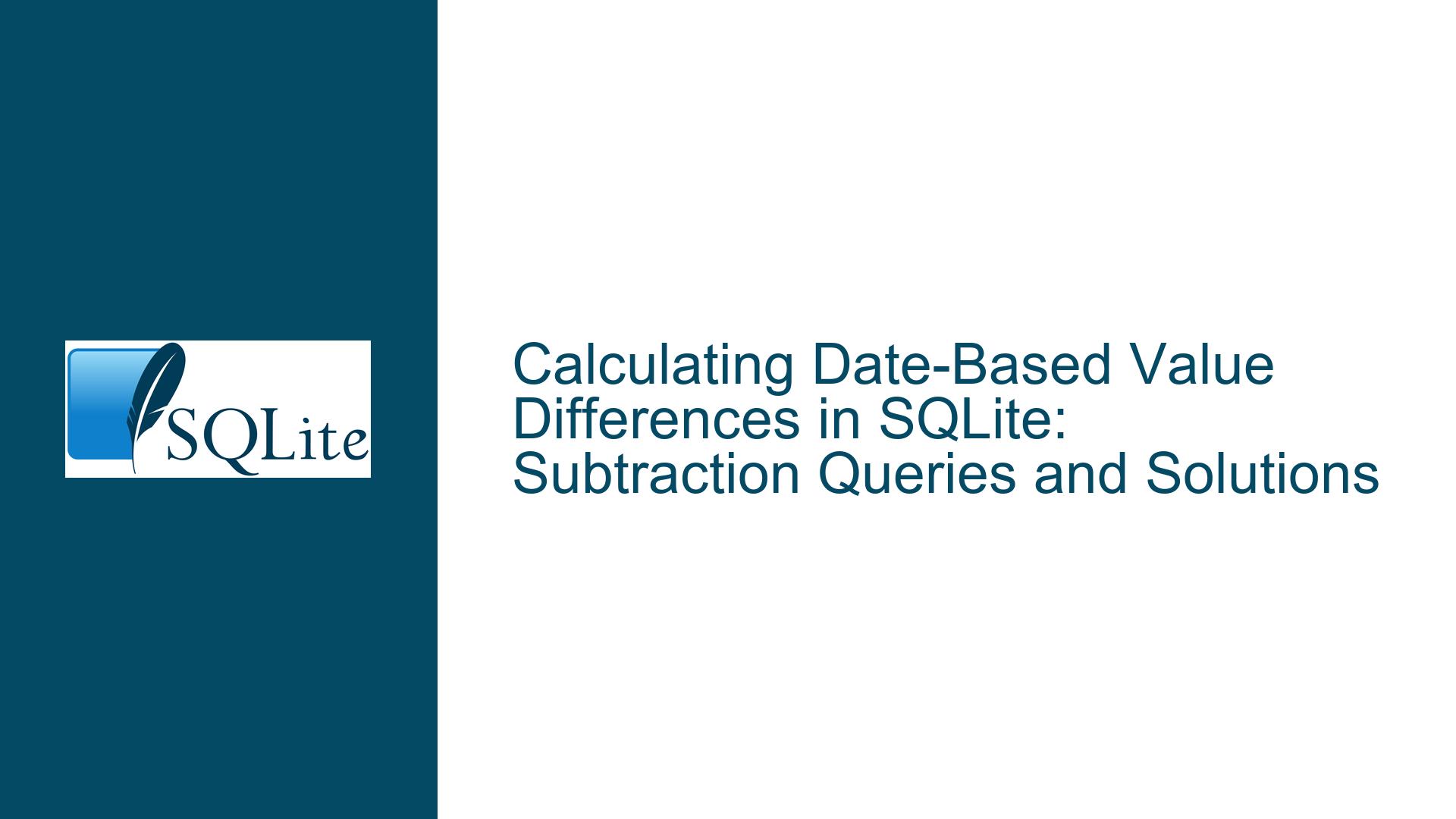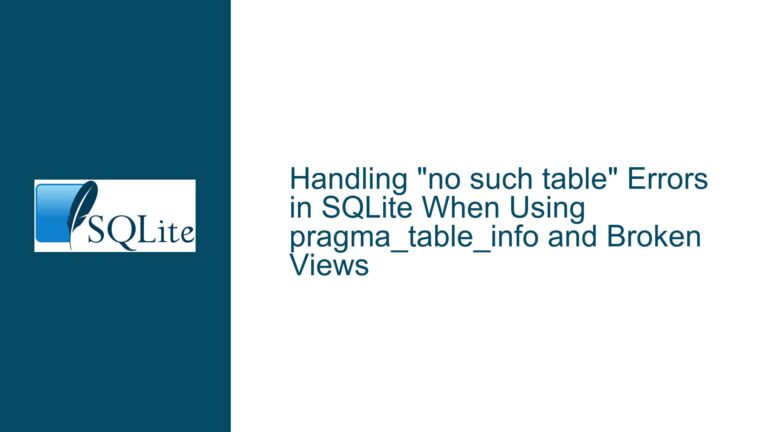Calculating Date-Based Value Differences in SQLite: Subtraction Queries and Solutions
Understanding the Challenge of Subtracting Values from Two Dates in SQLite
Issue Overview
The core challenge involves retrieving numeric values associated with two specific dates from a SQLite database table and calculating the difference between those values. The original poster’s table (Meterstanden) contains a date column (Datum) and a numeric column (Gas). The goal is to compute the arithmetic difference between the Gas value recorded 10 days ago and the value recorded 20 days ago. The initial attempt to achieve this used a query that attempted to subtract two date-based conditions directly in the WHERE clause, resulting in an empty result set despite the query executing without syntax errors. This outcome highlights a misunderstanding of SQLite’s query execution logic and the proper way to reference multiple rows for arithmetic operations.
The fundamental issue lies in the structure of the query. SQL operates on rows and columns in a way that requires explicit or implicit joins between data points when those points reside in separate rows. The original query attempted to subtract two logical conditions (Datum == date('now','-10 day') and Datum == date('now','-20 day')) as if they were numeric operands, which is invalid. The WHERE clause in SQL filters rows based on conditions; it does not perform arithmetic operations between rows. Consequently, the query returned no results because the logical expression Datum == date('now','-10 day') - Datum == date('now','-20 day') does not resolve to a valid filtering mechanism or arithmetic operation.
Root Causes of Incorrect Results in Date-Based Subtraction Queries
Possible Causes
Misuse of the Subtraction Operator in the WHERE Clause:
The-operator was applied to two logical expressions (Datum == ...), which is syntactically invalid. TheWHEREclause evaluates boolean conditions to filter rows, not to perform arithmetic between unrelated rows. This misuse led the database engine to interpret the entire expression as a nonsensical condition, resulting in no rows being returned.Single-Row Result Expectation vs. Multi-Row Reality:
The query assumed that subtracting two conditions would automatically retrieve two distinct rows (one for each date) and compute their difference. However, SQLite processes theWHEREclause row by row, evaluating each row independently against the conditions. Since no single row can satisfy bothDatum == date('now','-10 day')andDatum == date('now','-20 day')simultaneously, the query failed to fetch any rows.Date Format Mismatches or Nonexistent Dates:
If theDatumcolumn stores dates in a format incompatible with SQLite’sdate()function, or if no rows exist for the calculated dates (now - 10 daysornow - 20 days), the subqueries or joins would returnNULL, leading to an empty or incorrect result.Ambiguous Column Reference in Self-Join Scenarios:
In queries that join a table to itself (self-joins), failing to alias the table references or specify the source of each column can lead to ambiguous column errors or unintended cross-join results.
Strategies for Correctly Computing Differences Between Date-Based Values
Troubleshooting Steps, Solutions & Fixes
1. Subquery-Based Subtraction
The most straightforward solution involves using subqueries to isolate the Gas values for the two target dates and then subtracting them:
SELECT (
SELECT Gas FROM Meterstanden
WHERE Datum = date('now', '-10 day')
) - (
SELECT Gas FROM Meterstanden
WHERE Datum = date('now', '-20 day')
) AS GasDifference;
How It Works:
- The first subquery retrieves the
Gasvalue fornow - 10 days. - The second subquery retrieves the
Gasvalue fornow - 20 days. - The outer query subtracts the second result from the first.
Pitfalls:
- If either subquery returns no rows (e.g., no data for the target dates), the result will be
NULL. - If multiple rows exist for either date, the subquery will return multiple values, causing an error. Ensure date uniqueness or use
LIMIT 1.
Validation:
- Verify the existence of rows for the target dates:
SELECT Datum FROM Meterstanden WHERE Datum IN (date('now', '-10 day'), date('now', '-20 day'));
2. Self-Join Approach
A self-join explicitly links two instances of the table to reference the two target rows:
SELECT
a.Gas - b.Gas AS GasDifference
FROM
Meterstanden AS a
JOIN Meterstanden AS b
WHERE
a.Datum = date('now', '-10 day')
AND b.Datum = date('now', '-20 day');
How It Works:
- The table is aliased as
aandb, representing the two dates. - The join condition filters
atonow - 10 daysandbtonow - 20 days. - The subtraction is performed between the
Gasvalues of the two aliases.
Pitfalls:
- Without an explicit join key (e.g.,
ON a.id = b.id), this becomes a cross-join, which may produce unintended results if the table has multiple rows. - Like the subquery method, missing dates will result in no rows being returned.
Optimization:
- Add an index on the
Datumcolumn to speed up lookups:CREATE INDEX idx_meterstanden_datum ON Meterstanden(Datum);
3. Window Function Calculation
For scenarios involving sequential or periodic measurements, window functions can compute differences directly:
WITH DateFiltered AS (
SELECT
Gas,
Datum,
LAG(Gas, 1) OVER (ORDER BY Datum) AS PreviousGas
FROM Meterstanden
WHERE Datum IN (date('now', '-20 day'), date('now', '-10 day'))
)
SELECT
Gas - PreviousGas AS GasDifference
FROM DateFiltered
WHERE Datum = date('now', '-10 day');
How It Works:
- The
LAG()function retrieves theGasvalue from the previous row in the ordered result set. - The
WHEREclause in the CTE restricts processing to the two target dates. - The outer query selects the difference for the more recent date.
Pitfalls:
- The
INclause’s order is not guaranteed; useORDER BY Datumin the CTE to ensure chronological sequencing. - Requires SQLite 3.25+ for window function support.
4. Handling Missing Dates and Edge Cases
- Coalesce Defaults: Use
COALESCE()to substituteNULLwith a default value (e.g., 0) if a date is missing:SELECT COALESCE((SELECT Gas FROM Meterstanden WHERE Datum = date('now', '-10 day')), 0) - COALESCE((SELECT Gas FROM Meterstanden WHERE Datum = date('now', '-20 day')), 0) AS GasDifference; - Parameterized Dates: Replace hardcoded date calculations with parameters for flexibility:
SELECT (SELECT Gas FROM Meterstanden WHERE Datum = :date1) - (SELECT Gas FROM Meterstanden WHERE Datum = :date2) AS GasDifference;
5. Date Format and Timezone Considerations
- ISO 8601 Compliance: Ensure
Datumstores dates inYYYY-MM-DDformat to align with SQLite’sdate()function. - Timezone Adjustments: Use
datetime()with modifiers for local timezone handling:SELECT date('now', '-10 days', 'localtime');
6. Comprehensive Validation Workflow
- Confirm Date Values:
SELECT date('now', '-10 day'), date('now', '-20 day'); - Check for Matching Rows:
SELECT COUNT(*) FROM Meterstanden WHERE Datum = date('now', '-10 day'); - Test Subqueries Individually:
SELECT Gas FROM Meterstanden WHERE Datum = date('now', '-10 day');
By systematically addressing these areas—query structure, date handling, and edge cases—the difference between date-based values can be reliably computed in SQLite.






